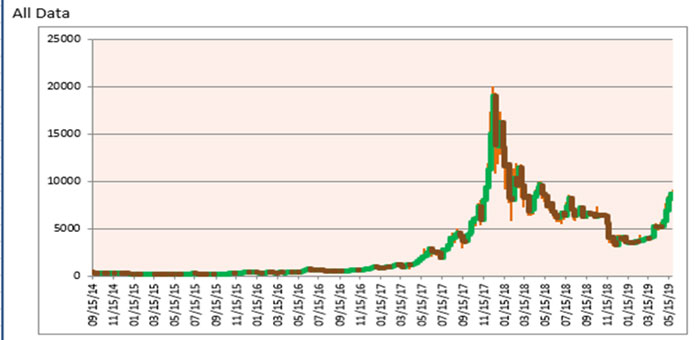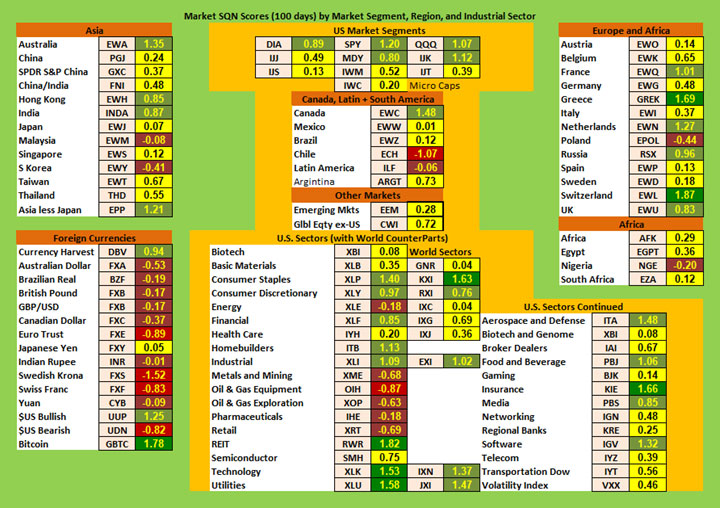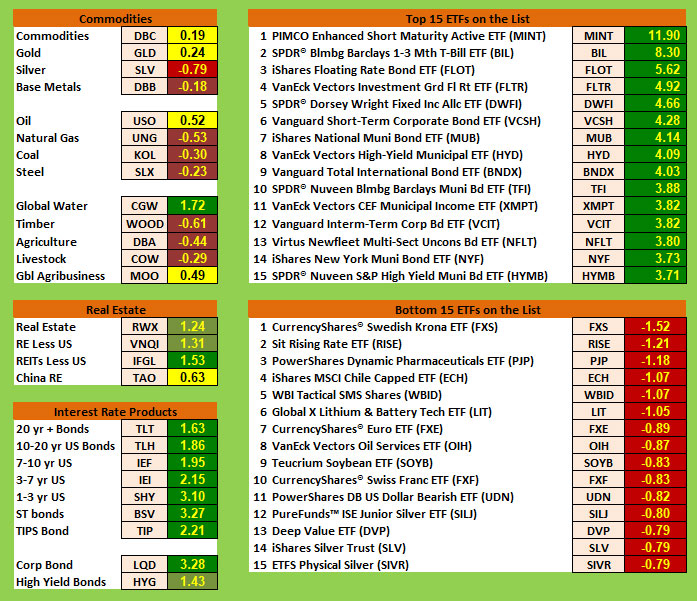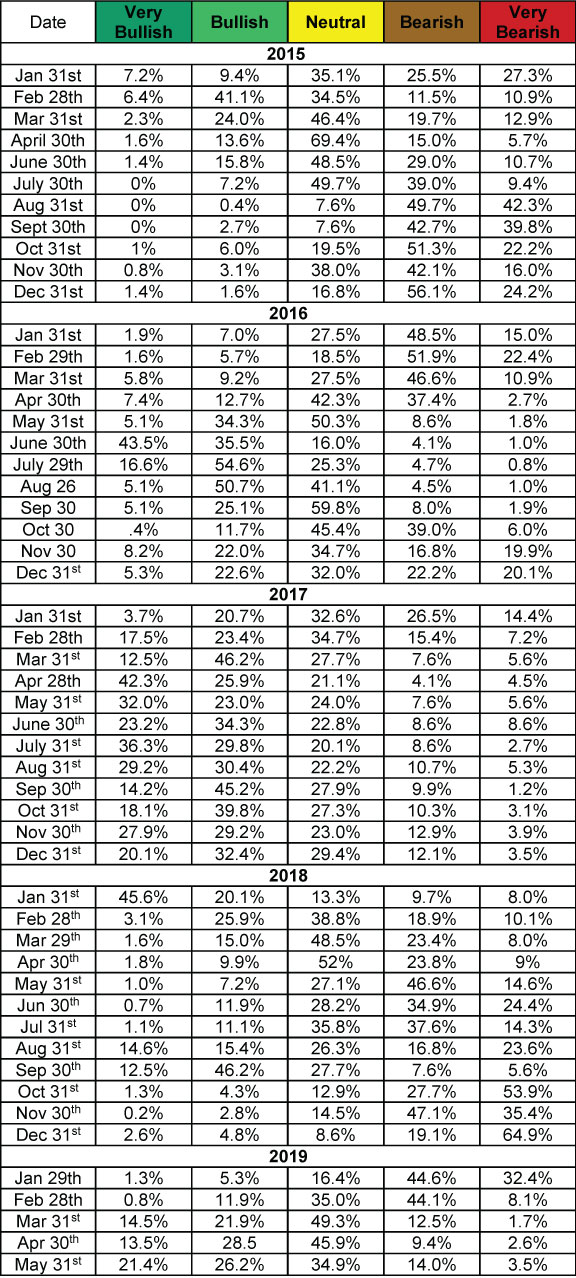 There are numerous ETFs that track everything from countries, commodities, currencies and stock market indices to individual market sectors. ETFs provide a wonderfully easy way to discover what’s happening in the world markets. I apply a version of my System Quality Number® (SQN®) score to measure the relative performance of numerous markets in a world model.
There are numerous ETFs that track everything from countries, commodities, currencies and stock market indices to individual market sectors. ETFs provide a wonderfully easy way to discover what’s happening in the world markets. I apply a version of my System Quality Number® (SQN®) score to measure the relative performance of numerous markets in a world model.
The Market SQN score uses the daily percent change for input over a 100-day period. Typically, a Market SQN score over 1.47 is strongly bullish and a score below -0.7 is very weak. The following color codes help communicate the strengths and weaknesses of the ETFs in this report:
- Dark Green: ETFs with very strong Market SQN scores > 1.47
- Light Green: ETFs with strong Market SQN scores (0.70 to 1.47).
- Yellow: ETFs with slightly positive Market SQN scores (0 to 0.70). These are Neutral/Sideways
- Brown: ETFs with slightly negative Market SQN scores (0 to -0.7).
- Red: Very weak ETFs that earn negative Market SQN scores (< -0.7).
This is basically the same rating scale that we use for the Market SQN Score in the Market Update. The world market model spreadsheet report below contains a cross section of currently available ETFs; excluding inverse funds and leveraged funds. In short, it covers equity markets around the globe, major asset classes, equity market segments, industrial sectors, and major currencies.
World Market Summary — Equities & Currencies
Each month we look at the equities markets across the globe by segment, region, and sector.
The world market model had started to look much better recently but now the table is rather mixed. There’s lots of green still, but there is also a lot of brown, especially in currencies and commodities.
The US Dollar is the only green currency except for the currency harvest and GBTC (which we use to represent BTC in the model). The Japanese Yen is the only yellow currency and all the other currencies are brown (bear) or red (strong bear).
Bitcoin (represented by GBTC) is very strong right now and here’s a chart of weekly bars since the beginning of 2014. It’s easy to see what is happening. Watch for my mid-month update on cryptos for more information.

In the US equities market segments, the large caps (1st row) and most of the mid-caps (2nd row) are slightly bullish. The small caps and the microcaps however are sideways or yellow.
In the other countries in the Americas, Canada is bullish but Argentina, Mexico (before Trump’s most recent Mexican tariff threats), and Brazil are yellow. Chile is red and Latin America is brown.
In Asia, we have Australia (not really Asia but I put it there), Hong Kong, and India as green. Malaysia and South Korea are brown, and everything else is yellow.
In Europe, Switzerland (despite a weak Swiss Franc) is strong bull. And Greece is also dark green. France, the Netherlands, Russia, and the UK are all light green. Poland is the only brown with everything else being yellow (neutral).
In Africa, Nigeria is brown and everything else is yellow.

If we look at the US sectors, we have REITS, Technology, Utilities, and Insurance being dark green. Consumer Staples, Consumer Discretionary, Homebuilders, Industrial, Aerospace and Defense, Food and Beverage, Media and Software are all light green.
On the downside, Oil and Gas Equipment are red, while Energy, Metals and Mining, Oil and Gas Exploration, Pharmaceuticals, and Retail are all brown. The rest are neutral or yellow.
Commodities, Real Estate, Debt, and the Top and Bottom Lists

Commodities were mixed with a varied range of Market SQN scores. It’s interesting that Oil shows up as neutral (bullish last week) while the oil related stocks were very weak. Global Water is also strong.
The weakest commodity is Silver (which is red). Base Metals, Natural Gas, Coal, Steel, Timber, Agriculture, and Livestock are all brown (weak). Global Agribusiness, Oil and Gold are neutral.
Because interest rates are not going up any more, the interest product sector is all dark green except for junk bonds which are still light green. Notice that Corporate Bonds have a Market SQN® score above 3.2.
US Real Estate is light green while Chinese Real Estate is neutral.
What’s really interesting is that the 15 strongest ETFs are all dark green like last month. Last month the lowest ranking of the top 15 was 3.26. This month you need 3.71 to make the top 15 and the top nine are all above 4.0. I’ve never see a double digit Market SQN in the SQN Report, but MINT makes it with 11.9. It was 8.64 last month. I can’t imagine it staying there, so look for it to be much lower next month. All of the top 15 have to do with interest rates.
This is a good example showing that a high Market SQN score has a lot to do with very steady climb with little volatility on the way up. I expect that’s the case with all of these interest rate ETFs. Contrast those charts, however, with BTC which doubled in about two months. On Mar 31st BTC was at $4112.69 and on May 31st it was $8555.87. No ETF in the top 15 has done anything close to that but GBTC’s Market SQN score was only 1.78.
On the negative side, all of the bottom 15 are red but the worst was the Swedish Krona at -1.52. Last month the weakest score was minus 1.88.
Summary
Let’s look at the summary table which measures the percentage of ETFs in each of the strength categories. You can see the distribution of the database by Market SQN score in bullish, neutral and bearish categories below —
By the end of May, we had more bullish ETFs than last month, but also more bearish ETFs than last month, while neutral ETFs went down by eleven percentage points. We have 21% of the model being very bullish which is the highest score since Jan 2018.
We are back to a bull market but as I said in this month’s update — it’s riskier than last month with more volatility and the Market SQN for the S&P 500 showing a bullish score in only one out of the four timeframes I watch.
Finally, cryptos are now in a strong bull market type. The reward to risk ratio for cryptoassets has become quite attractive though as an asset class, the risk still remains very high. The risk of buying and holding crytpoassets will come down over time but then so will the potential returns. The simple crypto trading system I have taught to some of the Super Traders (who have met certain criteria) is now long a number of cryptos — all with extremely limited risk amounts.
Be careful to base your actions upon what IS happening, not what you think might happen. The markets always offer opportunities, but to capture those opportunities, you MUST know what you are doing. If you want to trade these markets, you need to approach them as a trader, not a long-term investor. We’d like to help you learn how to trade professionally because trying to navigate the markets without an education is hazardous to your wealth. All the beliefs given in this update are my own. Though I find them useful, you may not. You can only trade your own beliefs about the markets.


I am in the process of reading your book “Trade Your Way to Financial Freedom” and finding many useful insights. Saw reference to Tharp’s Thoughts and Ken Longs weekly comments on the market. Would be interested in know if there is a mailing list to be added to, so I get the report link.
Thank you,
There is, if you scroll to the bottom of your screen in the right-hand corner enter your email for inbox coaching and you will be added to our newsletter list.